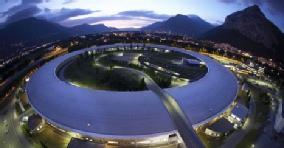An early XMaS present: BIS and ESPRC award £6 million to enable University of Warwick co-owned x-ray facility to continue delivering world-class science
|
UK government research funders have awarded £6 million to XMaS, the world leading mid range x-ray facility, to continue helping scientists explore the microscopic and atomic structure of matter.
The funding has been awarded to the facility’s owners at the Universities of Warwick and Liverpool, by the Engineering and Physical Sciences Research Council and the UK Government’s Department for Business Innovation and Skills.
Constructed in the mid-1990s, XMaS is based at the European Synchrotron Radiation in Grenoble. It has so far been used by more than 40 universities and research institutes helping them study the atomic and magnetic structures of materials and the properties they exhibit under different conditions at scales ten thousand times thinner than a human hair.
It works by focusing a beam of X-rays onto samples, the atoms of which deviate or absorb the radiation, leaving behind a ‘fingerprint’ in the outgoing beam that reveals the samples detailed structure.
Professor Thomas Hase of the University of Warwick said: “This continued funding is a real vote of confidence in the quality of science we do at XMaS.
“Requests for beam time are close to double what we can accommodate. For scientific facilities this is an ideal situation, representing a high enough demand to ensure only excellent, internationally competitive science is performed.
“Because of this approach we see a very healthy ratio of beam time to publication, with one new paper coming from every two experimental runs on average, and an increasing proportion of these are in the highest impact publications.”
Originally conceived as a tool to probe magnetic materials (hence the acronym X-ray Magnetic Scattering), its scope is now far broader with 20 active UK research groups (representing approximately 100 researchers) covering materials science, physics, chemistry, soft condensed matter and biomaterials. With this wider reach, the facility is able to contribute directly to societal challenges such as energy storage and recovery, the digital economy and advances in healthcare technologies.
Recent research highlights include:
- Testing existing techniques and exploring new methods to reducing corrosion of cultural heritage metals such as artefacts recovered rom the Mary Rose and historic church organs. This research is being carried out by the University of Warwick.
- Performing the world first detailed structural analysis of tooth growth and maturity to reconstruct ancient human migratory maps based on tooth analysis, and help scientists regrow teeth from stem cells or artificial implants.
- New advances in the study of magneto-electric materials that will underpin more efficient data storage.
As well as world leading research, XMaS scientists have also developed a wide range of new technology specifically for use on the instrument. Since 2003 exploitation licenses taken out on these innovations have generated close to 1 million Euros in sales to the global scientific community, and the equipment developed at XMaS has had a significant impact on the way experiments are carried out around the world.
Two of the best selling innovations to date are:
- The X-Y-Z Cryostat Mount - allows scientists to position samples within the beamline with sub-micron precision. In the past such precision was only achievable by interrupting the experiment, unlocking the radiation hutch and making the adjustments manually. Users estimate that the mount saves at least half a day’s worth of time during each run of experiments.
- Compact lever operated slits - can be incorporated in the vacuum path very close to the sample to reduce background scatter, the irrelevant noise that affects the resolution of the data produced.
Further Information
ENDS
For further information please contact University of Warwick press officer Anna Blackaby on 02476 575910 or 07785 433144 or a dot blackaby at warwick dot ac dot uk
Further Information
Read the case study on how the University of Warwick is using XMaS to study corrosion on historic artefacts such as 13th century organ pipes.
For further information please contact University of Warwick press officer Anna Blackaby on 02476 575910 or 07785 433144 or a dot blackaby at warwick dot ac dot uk

